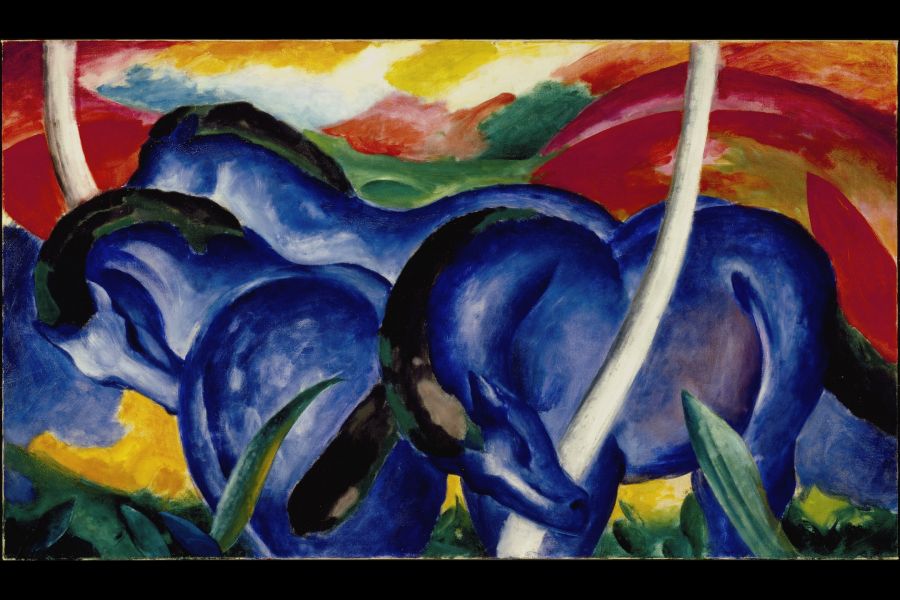Penny-Lynn Cookson
Special to Niagara Now/The Lake Report
In the world of art history we lionize the French artists, applaud the Americans, admire the audacity of many British artists and are finally recognizing the stunning work of many international, Indigenous and Black artists.
What is missing here is that we have been in the midst, if not the grip, of the most provocative art of all, the German art, culture, music and literature of the last 150 years. One of the most important artists of this “German era” is the painter and printmaker, Franz Marc.
Born in 1880 in Munich, Marc was the son of a landscape painter and brother of a Byzantine art specialist with whom he travelled to Greece. He abandoned studies in theology and philosophy in favour of art at the Academy of Fine Arts in Munich.
In 1903 and 1907 Marc was in Paris, visiting the Louvre, meeting artists and absorbing works by van Gogh, Gauguin and Picasso. But it was in Munich, where his alliance with Wassily Kandinsky led to the formation in 1911 of Der Blaue Reiter, (the Blue Rider), and German Expressionism.
As Kandinsky said, “I loved riders, Marc loved horses, and we both loved blue.” Their journal, “The Almanac,” featured a cover with a rider charging across a landscape on a blue horse.
For both, painting was deeply spiritual and they aimed to convey that spirituality and depth of human emotion through abstract forms and colours that transcended cultural and artistic boundaries. Marc’s goal was to “break out space and soul.”
Animal paintings were his means to express a pantheistic vision of the harmony of animals with their natural environment, their beauty and grace representing an ethereal, higher spiritual order. In “The Large Blue Horses,” three harmonious, grazing horses take up foreground space, their curves echoing the red rolling hills behind them.
He wrote, “I am trying to heighten my sense of the organic rhythm of all things …” Marc developed and employed a symbolic colour theory: blue is masculine, spiritual, pure, principled. Yellow is feminine, joyous, gentle, sensuous. Red is brutal, violent, heavy and must be overcome and opposed by the other colours.
Colours induce sensations. They affect our moods. Marc wrote an essay entitled “How Does a Horse See the World?' and his distortion of form and intense colour may be an attempt to see the world as the animal sees it.
In 1912, the influence of Robert Delaunay’s colour and futurist method led Marc to adopt sharper angles, fracturing and fragmentation which revealed his growing disenchantment with what was happening politically and socially in Germany. In his 1913, “Fate of the Animals,” a forest fire consumes the burning, suffering animals.
It was prescient of the cataclysm to come. On the back of the canvas he wrote, “And all being is flaming agony” and later he wrote, “it is like a premonition of this war, horrible and shattering. I can hardly conceive that I painted it.”
In 1914, Marc was drafted into the Imperial German Army as a cavalryman. He subsequently was painting military camouflage canvas covers in a broad pointillist dot style to hide artillery. In 1915, he wrote to his wife, “People with their lack of piety, especially men, never touched my true feelings. But animals with their virginal sense of life awakened all that is good in me.”
The German government identified Marc as one of the most important artists that should be exempt from combat but before the order reached him at the front, he was killed instantly by shrapnel in 1916 at the Battle of Verdun.
In his knapsack were many drawings of even more sharply fragmented and angled abstract images. And, a final quote: ‘On the whole, instinct has never failed to guide me.”
Penny-Lynn Cookson is an art historian who taught at the University of Toronto for 10 years. She was also head of extension services at the Art Gallery of Ontario. Register now for her upcoming Zoom series: “The Germans – Art, Faith and War,” Thursdays, 11 a.m. to noon, Sept. 23 to Oct. 28 at RiverBrink Art Museum.










